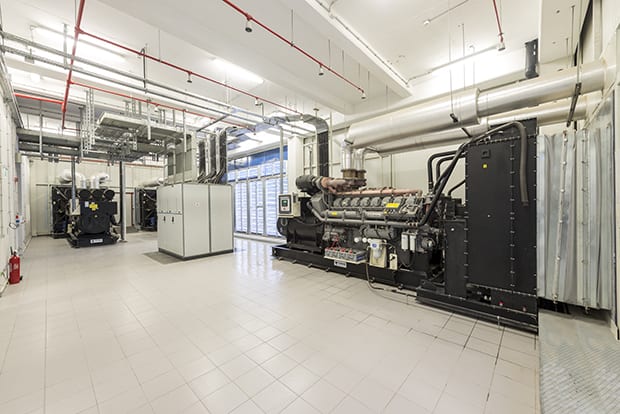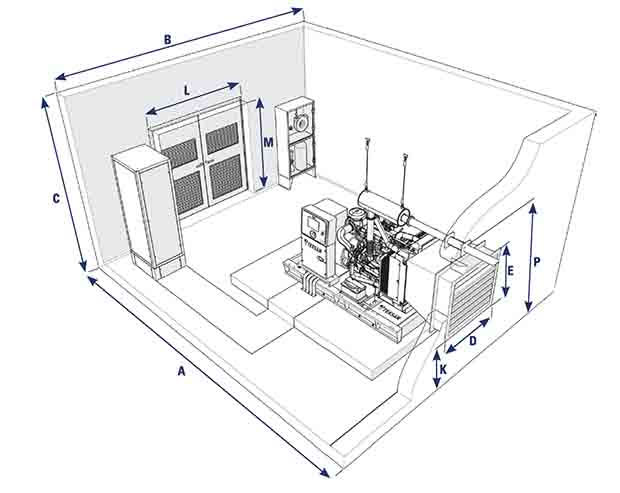How to Avoid Common Genset Room Design Mistakes
Reliable power is essential for all facilities, but it is even more critical for places like hospitals, data centers, and military bases. Therefore, many decision-makers are purchasing power generator sets (gensets) to supply their facilities during emergencies. It is crucial to consider where the genset will be positioned and how it will be operated. If you plan to position the genset in a room/building, you must make sure that it complies with all genset room design requirements.
The space requirements for emergency gensets are not typically at the top of an architect’s list for the building design. Because large power gensets take up a lot of space, problems do often occur when providing necessary areas for installation. At the beginning of a building/facility design, Teksan recommends that the design of the generator is carried out in consultation with experts in order to ensure that the genset operates with its equipment in a healthy manner.
Genset Room
The genset and its equipment (control panel, fuel tank, exhaust silencer, etc.) are integral together and this integrity should be considered during the design phase. The genset room floor should be liquid-tight to prevent leakage of oil, fuel, or cooling liquid into nearby soil. The generator room design must also comply with fire protection regulations.
The generator room should be clean, dry, well-lit, well-ventilated. Care must be taken to ensure heat, smoke, oil vapor, engine exhaust fumes, and other emission do not enter into the room. Insulating materials used in the room should be of the non-flammable/flame retardant class. Furthermore, the floor and base of the room should be designed for the static and dynamic weight of the genset.
Room Layout
The door width/height of the genset room should be such that the genset and its equipment can easily be moved into the room. Genset equipment (fuel tank, silencer, etc.) should be positioned close to the genset (Figure 1). Otherwise, pressure losses might occur and backpressure might increase.
 |
| 1. A well-designed emergency generator set room provides sufficient space for maintenance and operation of equipment without causing unnecessary backpressure on equipment. Courtesy: Teksan |
The control panel should be positioned correctly for ease of use by maintenance/operating personnel. Sufficient space should be available for periodic maintenance. There should be an emergency exit and no equipment (cable tray, fuel pipe, etc.) should be present along the emergency escape route that could prevent personnel from evacuating the building.
There should be three-phase/single-phase sockets, water lines, and air lines available in the room for ease of maintenance/operation. If the genset’s daily fuel tank is of external type, the fuel piping should be fixed up to the genset and the connection from this fixed installation to the engine should be made with a flexible fuel hose so that the engine vibration cannot be transmitted to the installation. Teksan recommends the fuel system be installed via a duct through the ground.
Power and control cables should also be installed in a separate duct. Because the genset will oscillate on the horizontal axis in case of start, first-step loading, and emergency stop, the power cable must be connected leaving a certain amount of clearance.
Ventilation
Ventilation of the genset room has two main purposes. They are to ensure that the life-cycle of the genset does not shorten by operating it correctly and to provide an environment for the maintenance/operation personnel so they can work comfortably.
In the genset room, right after the start, an air circulation begins due to the radiator fan. Fresh air enters from the vent located behind the alternator. That air passes over the engine and the alternator, cools the engine body to a certain degree, and the heated air is discharged into the atmosphere through the hot air outlet located in front of the radiator.
For efficient ventilation, the air inlet/outlet opening should be of suitable dimensions (Figure 2). Louvers should be fitted to the windows to protect the air outlets. The louver fins should have openings of sufficient dimensions to make sure that air circulation is not being blocked. Otherwise, the occurring backpressure might cause the genset to overheat. The biggest mistake made in this regard in genset rooms is the use of louver fin structures designed for transformer rooms rather than genset rooms. Information about air inlet/outlet opening sizes and louver details should be obtained from a knowledgeable consultant and from the manufacturer.
A duct should be used between the radiator and the air discharge opening. The connection between this duct and the radiator should be isolated using materials such as canvas cloth/canvas fabric in order to prevent the vibration of the genset from being conducted to the building. For rooms where ventilation is troubled, a ventilation flow analysis should be performed to analyze that ventilation can be performed properly.
The engine crankcase ventilation should be connected to the front of the radiator via a hose. In this way, oil vapor should be easily discharged from the room to the outside. Precautions should be taken so that rain water does not enter the crankcase ventilation line. Automatic louver systems should be used in applications with gaseous fire extinguishing systems.
Fuel System
The fuel tank design must comply with fire protection requirements. The fuel tank should be installed in a concrete or metal bund. The ventilation of the tank should be carried outside of the building. If the tank is to be installed in a separate room, there should be ventilation outlet openings in that room.
The fuel piping should be installed away from the hot zones of the genset and the exhaust line. Black steel pipes should be used in fuel systems. Galvanized, zinc, and similar metal pipes that can react with fuel should not be used. Otherwise, impurities generated by chemical reactions may clog the fuel filter or result in more significant problems.
Sparks (from grinders, welding, etc.), flames (from torches), and smoking should not be allowed in places where fuel is present. Warning labels must be assigned.
Heaters should be used for fuel systems installed in cold environments. Tanks and pipes should be protected with insulation materials. Filling of the fuel tank should be considered and designed during the room design process. It is preferred that the fuel tank and genset be positioned at the same level. If a different application is required, support from the genset manufacturer should be obtained.
Exhaust System
The exhaust system (silencer and pipes) is installed to reduce the noise from the engine and to direct the toxic exhaust gases to appropriate areas. Inhalation of exhaust gases is a possible death hazard. Penetration of the exhaust gas into the engine reduces engine life. For this reason, it should be sealed to the appropriate outlet.
The exhaust system should consist of flexible compensator, silencer, and pipes that absorb vibration and expansion. Exhaust pipe elbows and fittings should be designed to accommodate expansion due to temperature.
When designing the exhaust system, the main objective should be to avoid backpressure. The pipe diameter should not be narrowed in relation to the orientation and the correct diameter should be selected. For the exhaust pipe route, the shortest and least convoluted path should be selected.
A rain cap that is actuated via exhaust pressure should be used for vertical exhaust pipes. The exhaust pipe and silencer inside the room should be insulated. Otherwise, the exhaust temperature increases the room temperature, thus reducing the performance of the genset.
The direction and outlet point of the exhaust gas is very important. There should be no residential, facilities, or roads present in the direction of exhaust gas discharge. The prevailing wind direction should be considered. Where there is constrain regarding hanging the exhaust silencer on the ceiling, an exhaust stand can be applied.
—Umut Çetin is a senior project engineer with Teksan (www.teksan.com).
